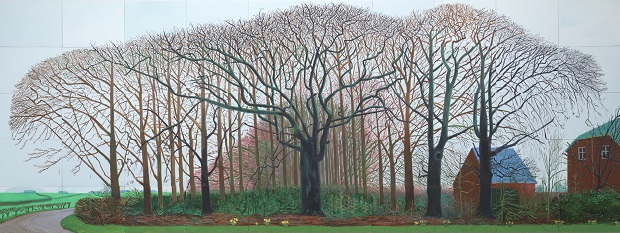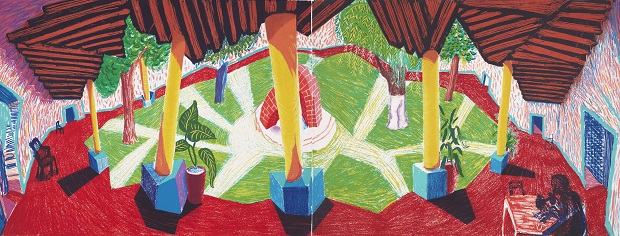- Daily & Weekly newsletters
- Buy & download The Bulletin
- Comment on our articles
Dive into the bold and bright world of David Hockney in double exhibition at Bozar
It’s the capital’s flagship exhibition this autumn, showcasing some of David Hockney’s finest works over a career spanning six decades, including a recent series of sometimes controversial digital paintings that defiantly celebrated spring during the first lockdown in 2020.
The dual show at Bozar until 23 January (also touring other European cities), is tipped to further reinforce the popularity of Britain’s most celebrated living artist. In the main exhibition, David Hockney: Works from the Tate Collection, 1954-2017, the full mastery of his draughtsmanship and evolving technique is on display. For curator Helen Little, “it’s a well-rounded and chronological presentation of his career to date”.
The second part, David Hockney: The Arrival of Spring, Normandy 2020 is testimony to the 84 year-old’s unerring grit in exploring new technology. Curator Edith Devaney described how Hockney spent a year perfecting his painting technique with an iPad app custom-designed for the artist. She said he was inspired by the narrative art of the Bayeux Tapestry and Chinese scroll paintings when capturing the fleeting moments of the spring landscape surrounding his new home in Normandy.
With the last retrospective of the artist dating from 1992, Bozar’s head of exhibitions and director general-to-be Sophie Lauwers, said: “This big splashdown into the timeless universe of David Hockney is needed today more than ever”.
 Serving as a prelude to the show is Hockney’s largest work to date, Bigger Trees near Warter (pictured above). Depicting his native Yorkshire and painted onto 50 panels, it’s a stark yet detailed scene dominated by immense threatening sycamores, while blossoming daffodils in the foreground herald the imminent arrival of spring.
Serving as a prelude to the show is Hockney’s largest work to date, Bigger Trees near Warter (pictured above). Depicting his native Yorkshire and painted onto 50 panels, it’s a stark yet detailed scene dominated by immense threatening sycamores, while blossoming daffodils in the foreground herald the imminent arrival of spring.

His surprising early works date from the 1960s when the Royal College of Art graduate stormed the London art scene. The First Marriage (A Marriage of Styles I), (pictured above) reflects abstract expressionism, where elsewhere we see his contributions to the Pop Art movement. A series of etchings for A Rake’s Progress was inspired by William Hogarth’s series of the same name, drawing on his own self-discovery experiences as a young artist and homosexual man.
 Hockney’s career was launched internationally when he moved to Los Angeles in 1964. He died his hair its trademark blonde and immersed himself in the city landscape, blending representation and abstraction in sun-drenched portraits, interiors and landscapes. Hockney’s meticulousness in his drawing skills translates into his application of paint: flattened simplified shapes set against geometrical grids of minimalist art and modernish architecture. If some of his most famous pool pictures are missing from this collection, there’s a sufficient display of his fascination with water and the technical challenge it presented as a moving material, seen in Man in Shower in Beverley Hills (pictured above).
Hockney’s career was launched internationally when he moved to Los Angeles in 1964. He died his hair its trademark blonde and immersed himself in the city landscape, blending representation and abstraction in sun-drenched portraits, interiors and landscapes. Hockney’s meticulousness in his drawing skills translates into his application of paint: flattened simplified shapes set against geometrical grids of minimalist art and modernish architecture. If some of his most famous pool pictures are missing from this collection, there’s a sufficient display of his fascination with water and the technical challenge it presented as a moving material, seen in Man in Shower in Beverley Hills (pictured above).
 Naturalism continued in a series of large-scale portraits that include some of his most iconic works. Mr and Mrs Clark and Percy (pictured above) was painted in the home environment of the pair’s London flat. From the symbolism of the image - a stylish, socially mobile couple harking back to traditional portraits - to the vibrant colour palette and sophisticated technique of the brushwork, it remains a modern design statement.
Naturalism continued in a series of large-scale portraits that include some of his most iconic works. Mr and Mrs Clark and Percy (pictured above) was painted in the home environment of the pair’s London flat. From the symbolism of the image - a stylish, socially mobile couple harking back to traditional portraits - to the vibrant colour palette and sophisticated technique of the brushwork, it remains a modern design statement.

Less familiar, but no less absorbing, is Hockney’s portrait My Parents (pictured above). The contrasting stance between the couple no doubt reflects their disparate personalities, while references to Chardin and della Francesca inject an intellectual element into the domestic and emotional scene.

By the 1980s, Hockney had eschewed naturalism, exploring photography among other styles and print techniques. Continuing into the 1990s, he experimented and painted in various locations, from Mexico to the Grand Canyon, adopting what he called a Matisse colour palette, as in the lithograph Hotel Acatlan: Two Weeks Later (pictured above).
Returning to Yorkshire in the early 2000s to care for his ailing mother, Hockney was inspired to produce a series of monumental landscapes. It was also a period when he made his first foray into new technology, which leads into the second part of the exhibition. Bearing the message, “you can’t cancel spring”, Hockney’s 116 iPad works are a collection of largely fluorescent green depictions of nature; scenes devoid of human life.
 Hockney designates them paintings and recalls other plein air artists such as Monet in his water lily image (pictured above). Representations of the moon in moody dark skies stand out among the almost relentless green hues of Hockney’s spring lockdown (pictured below).
Hockney designates them paintings and recalls other plein air artists such as Monet in his water lily image (pictured above). Representations of the moon in moody dark skies stand out among the almost relentless green hues of Hockney’s spring lockdown (pictured below).
 Helen Little agrees that the show’s transition from his older works to the new iPad series can come as a shock. “Are they prints, are they drawn, are they painted? I think he delights in being able to create pictures that are so difficult to categorise.”
Helen Little agrees that the show’s transition from his older works to the new iPad series can come as a shock. “Are they prints, are they drawn, are they painted? I think he delights in being able to create pictures that are so difficult to categorise.”
She labels him an “absolute maestro” in being able to switch from one medium to another. “He really does genuinely believe that an iPhone and an iPad is a tool that has an equal value to a brush and a pencil and a printer’s stylus.”
As for the reason for Hockney’s continuing popularity, Little refers to an interview early in his career when asked a similar question. “He gave a simple but very powerful answer: ‘I think that I’m only asking people to look and to look in a slightly different way’.”
She believes that critics have been unkind to Hockney over the years. “Often, his incredible popularity has overshadowed the seriousness and the rigour of his ideas that have contained and sustained him throughout the 60 years of his work. He’s always been so driven as an artist to tell stories and to make impactful pictures that people find joyful and accessible and meaningful. I think all of those things run right through this exhibition and 60 years of his practice. I think that is his secret.”
David Hockney at Bozar
Until 23 January
Photos: In the Studio, December 2017, Tate © David Hockney, assisted by Jonathan Wilkinson (main image); Bigger Trees near Warter or/ou Peinture sur le Motif pour le Nouvel Age Post-Photographique 2007 Tate © David Hockney, photo Prudence Cuming Associates; The First Marriage (A Marriage of Styles I) 1962 Tate © David Hockney; Man in Shower in Beverly Hills 1964 Tate © David Hockney; Mr and Mrs Clark and Percy 1970-71 Tate © David Hockney; My Parents 1977 Tate © David Hockney; Hotel Acatlan: Two Weeks Later 1985 Tate © David Hockney/Tyler Graphics Ltd, photo Richard Schmidt; No 340 iPad painting © David Hockney; No 370 iPad painting © David Hockney



















